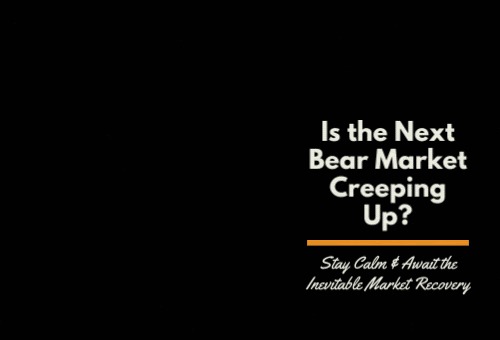
By Steve Lowrie, CFA
Special to the Financial Independence Hub
If you won a round-trip ticket on a backward-moving time machine, what period would you visit? One I’d probably skip would be April 2018. Why bother, since the market climate wasn’t all that different from today? Consider this commentary:
“U.S. stock markets ended in the red on Thursday with all three major indexes declined broadly. Thursday’s earnings results failed to live up to investor’s [sic] expectations despite remain[ing] strong. Moreover, a spike in the yield of 10-year Treasury Note also panicked investors. However, the markets shed some of its losses in the final hour of trading …” blah blah blah.
— Nasdaq Stock Market News for April 20, 2018
Sound familiar? While we now know no bear market materialized, some investors were questioning whether it was time to get out, while the gettin’ seemed good. To explain why market-timing is always a bad idea, I published a post then, to review the timeless tenets of evidence-based investing.
Returning to early February 2022, we are once again seeing some volatility in bond and stock markets. Not surprising, given the strong equity returns over the past 18 months and the fact that most central banks have indicated they will be raising interest rates to tackle inflation.
Will the bear awaken this time? Maybe yes, maybe no. Either way, my advice isn’t going to change, so let’s revisit what I wrote back then.
But first, let’s talk about you. What sort of investor are you?
I enjoyed a recent post from “The Psychology of Money” author Morgan Housel, who pointed out that it’s misleading to “lump everyone into one category called ‘investors’ and view them as playing on the same field called ‘markets’”.
Two people can have vastly differing time horizons, goals, and objectives. When you multiply this by millions of market participants, you see how inaccurate it is to paint everyone with the exact same “investor” brush.
So, let’s be clear: Are you investing to complete your long-term, multi-generational financial journey? If so, we write our posts for you. And for you, Housel hit the nail on the head with this observation, with which I fully agree:
“Bubbles do their damage when long-term investors playing one game start taking their cues from those short-term traders playing another.”
If you are a short-term trader, I wish you all the best in your market activities. However, you probably won’t find my pointers all that helpful. You may prefer Reddit instead.
In that context (if you’re still here), let’s look back at my thoughts from April 2018 …
As we write this piece in April 2018, overall market temperatures have been relatively mild for quite a while. Many newer investors have yet to weather a perfect market storm, and even those who have may have forgotten how panic-inducing they can be. But a bear market could be on the horizon.
To help you prepare for the next market downturn, or respond if you’re reading this during one, here are 10 timely actions you can take when financial markets are tanking to get your through to market recovery. Frankly, these tips are valid during any stage of the financial markets.
- Don’t panic (or pretend not to). It’s easy to believe you’re immune from panic when the financial sun is shining, but it’s hard to avoid indulging in it during a bear market crisis. If you’re entertaining seemingly logical excuses to bail out during a steep or sustained market downturn, remember: it’s highly likely your behavioral biases are doing the talking. Even if you only pretend to be calm, that’s fine, as long as it prevents you from acting on your fears before you see the light at the end of the tunnel with market recovery.
Every time someone says, ‘There is a lot of cash on the sidelines,’ a tiny part of my soul dies. There are no sidelines.” – Cliff Asness, AQR Capital Management
- Redirect your energy. No matter how logical it may be to sit on your hands during market downturns, your “fight or flight” instincts can trick you into acting anyway. Fortunately, there are productive moves you can make during a bear market instead – such as all 10 actions here – to satisfy the itch to act without overhauling your investments at potentially the worst possible time.
My advice to a prospective active do-it-yourself investor is to learn to golf. You’ll get a little exercise, some fresh air and time with your friends. Sure, green fees can be steep, but not as steep as the hit your portfolio will take if you become an active do-it-yourself investor.” – Terrance Odean, behavioral finance professor
- Remember evidence based investing. One way to ignore your self-doubts during market crises is to follow what decades of practical and academic evidence have taught us about investing: capital markets’ long-term trajectories have been upward. Thus, if you sell when markets are down, you’re far more likely to lock in permanent losses than come out ahead. Trust evidence based investing principles.
Do the math. Expect catastrophes. Whatever happens, stay the course.” – William Bernstein, MD, PhD, financial theorist and neurologist
- Manage your exposure to breaking bear market news. There’s a difference between following current events versus fixating on them. In today’s multitasking, multimedia world, it’s easier than ever to be inundated by late-breaking news. When you become mired in the minutiae, it’s hard to retain your long-term perspective.
Choosing what to ignore – turning off constant market updates, tuning out pundits purveying the latest Armageddon – is critical to maintaining a long-term focus.” – Jason Zweig, The Wall Street Journal
- Revisit your carefully crafted investment plans (or make some). Even if you yearn to go by gut feel during a financial crisis, remember: You promised yourself you wouldn’t do that. When did you promise? When you planned your personalized investment portfolio, carefully allocated to various sources of expected returns, globally diversified to dampen the risks involved, and sensibly executed with low-cost funds managed in an evidence-based manner. What if you’ve not yet made these sorts of plans or established this kind of portfolio? Then these are actions we encourage you to take at your earliest convenience.
The key to successful investing is to get the plan right and then stick to it. This means acting just like the lowly postage stamp that does one thing but does it well. It sticks to its letter until it reaches its destination. The investors’ job is to stick to their well thought out plan (if they have one) until they reach their destination. And if they don’t have a plan, write one immediately.” – Larry Swedroe, financial author
- Reconsider your risk tolerance (but don’t act on it just yet). When you craft a personalized investment portfolio, you also commit to accepting a measure of market risk in exchange for those expected market returns. Unfortunately, during quiet times, it’s easy to overestimate how much risk you can stomach. If you discover you’re miserable to the point of breaking during even modest market declines, you may need to re-think your investment plans. Start planning for prudent portfolio adjustments, preferably working with an objective independent financial advisor to help you implement them judiciously over time.
Our aversion to leverage has dampened our returns over the years. But Charlie [Munger] and I sleep well. Both of us believe it is insane to risk what you have and need in order to obtain what you don’t need.” – Warren Buffett, Berkshire Hathaway
- Double down on your risk exposure – if you’re able. If, on the other hand, you discover you’ve got nerves of steel, a bear market can be opportunities to buy more of the depressed (low-price) holdings that fit into your long-range investment plan. You can do this with new money, or by rebalancing what you’ve got (selling appreciated assets to buy the underdogs). This is not for the timid! You’re buying holdings other investors are fleeing in droves. But if you’re able to do this and hold tight, you’re especially well-positioned to make the most of the expected market recovery.
Pick your risk exposure, and then diversify the hell out of it.” – Eugene Fama, Nobel laureate economist
- Tax-loss harvest. Depending on market conditions as well as your own circumstances, you may be able to use tax-loss harvesting to turn financial lemons into lemonade during market downturns. A successful tax-loss harvest lowers your tax bill without substantially altering or impacting your long-term investment outcomes. This action is not without its tricks and traps, however, so it’s best done in alliance with a financial professional who is well-versed in navigating the challenges involved.
In investing, you get what you don’t pay for.” – John C. Bogle, Vanguard founder
- Revisit this article. There is no better time to re-read this article than when today’s “safety drill” is no longer an exercise but a real event. Maybe it will take your mind off the barrage of breaking news.
We’d never buy a shirt for full price then be O.K. returning it in exchange for the sale price. ‘Scary’ markets convince people this unequal exchange makes sense.” – Carl Richards, Behavior Gap
- Talk to us. We don’t know when. We don’t know how severe it will be, or how long it will last. But sooner or later, we expect the markets will tank again for a while, just as we also expect eventual market recovery. We hope today’s drill will help you be better prepared for “next time.” We also hope you’ll be in touch if we can help. After all, there’s never a bad time to receive good advice.
In the old legend the wise men finally boiled down the history of mortal affairs into the single phrase, ‘This too will pass.’ Confronted with a like challenge to distill the secret of sound investment into three words, we venture the motto, MARGIN OF SAFETY.” – Benjamin Graham, economist, “father of value investing”
Calm perseverance until market recovery is key to sticking with your investment plan for long-term success
If you found these tips helpful, then you are on the same page as Lowrie Financial’s personal investment planning style. Reach out anytime you’re feeling the pressure of a market storm so that I can help you get through to the market recovery with your long-term investment plans intact.
 Steve Lowrie holds the CFA designation and has 25 years of experience dealing with individual investors. Before creating Lowrie Financial in 2009, he worked at various Bay Street brokerage firms both as an advisor and in management. “I help investors ignore the Wall and Bay Street hype and hysteria, and focus on what’s best for themselves.” This blog originally appeared on his site on Feb. 7, 2022 and is republished here with permission.
Steve Lowrie holds the CFA designation and has 25 years of experience dealing with individual investors. Before creating Lowrie Financial in 2009, he worked at various Bay Street brokerage firms both as an advisor and in management. “I help investors ignore the Wall and Bay Street hype and hysteria, and focus on what’s best for themselves.” This blog originally appeared on his site on Feb. 7, 2022 and is republished here with permission.



Great post. I was wondering, at what point are my investments really down? For example, if today they are down by 1% from yesterday, but up 7% from the year before, are they really down. Similarly, if they are down 5% from the day before, but up by 3% from the year before and I’ve received 5% in dividends in the past 12 months, again, am I really down?
I’m just curious, how to know when my investments are really down.